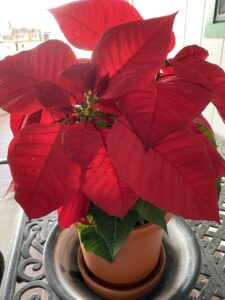
Last week I was at our local garden center and couldn’t resist the Poinsettia display. Poinsettias weren’t part of my childhood holiday season, but now I can’t imagine the fall and winter festivities without them.
Poinsettias didn’t always have a Christmas association. They were a lowly, yet useful, Mexican shrub the Aztecs called Cuitlaxochitl. The white sap could be used to control fevers, and the colorful bracts were part of a red-purple dye. Poinsettias didn’t grow in Tenochtitlan, the Aztec capital, but were delivered by caravan from the lowlands.
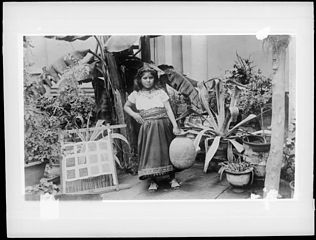
The Poinsettia began its festive journey in the 17th century when Franciscan fathers near Taxco began to use the plant in the Fiesta de Santa Pessebre, a nativity procession.
A Mexican legend tells the story of Pepita, a poor girl who had no present to give the baby Jesus. As she walked to the chapel on Christmas Eve, her cousin Pedro told her Jesus is happy with even the smallest gift from someone who loves him.
Pepita picked some weeds from the side of the road, and placed them at the bottom of the nativity scene. The weeds burst into bright red “flowers” that became known as Flores de Noche Buena (Flowers of the Holy Night).
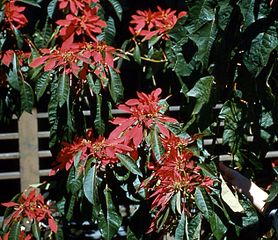
Left to their natural devices, Poinsettias can grow to more than ten feet tall. In Hawaii, this Pua Kalikimaka, grew wild on a hillside.
Joel Roberts Poinsett introduced the Poinsettia to the U. S. in 1828. While serving as the American ambassador to Mexico, Poinsett toured the country and encountered Poinsettias near Taxco de Alarcon. I don’t know the date, but it must have been when the plant sported its red bracts. He sent cuttings of the Mexican plant home to be planted in his greenhouses at Greenville, South Carolina. As the plant took hold, he sent samples to friends and botanical gardens.
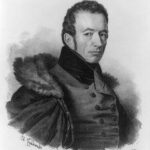
Poinsett had an extensive diplomatic and political career, but today is known for the exotic plant he introduced. The word Poinsettia is capitalized because it’s taken from a person’s name.
The plant’s botanical name, Euphorbia pulcherrima, means “very beautiful.”
Poinsettia flowers are the very small blossoms at the center of the plant. The colorful foliage is technically known as bracts, modified leaves. The bracts are created by a process known as photoperiodism, meaning they require periods of darkness that last 12 hours at a time, five days in a row for the color to change. Hence, they are at their most spectacular as the days shorten.
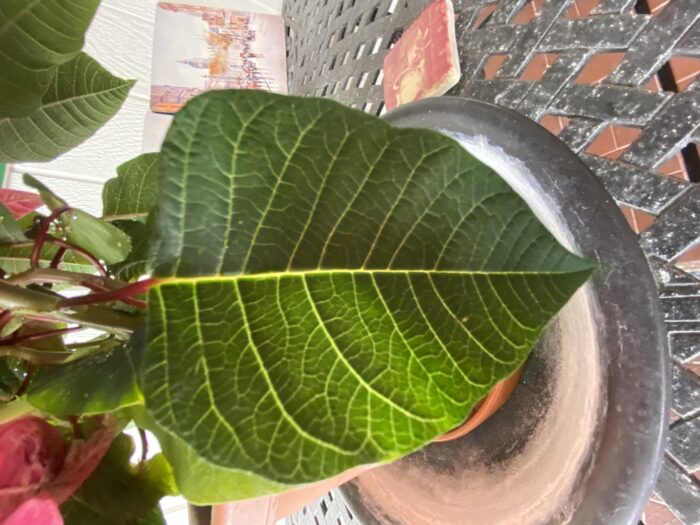
Green Bract 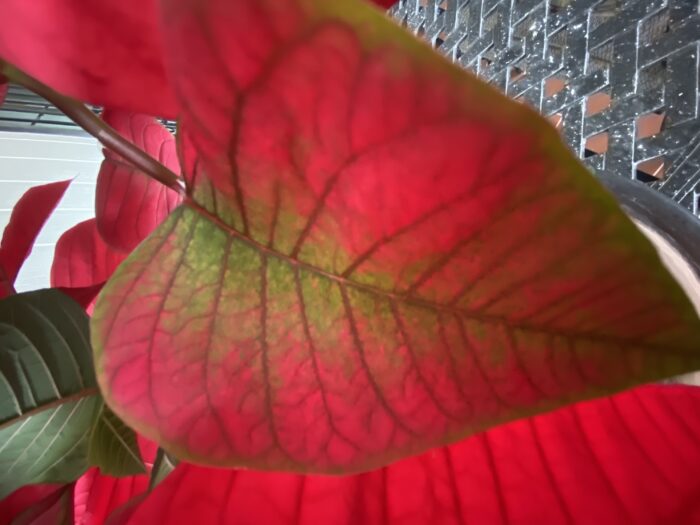
Bract Changes Color 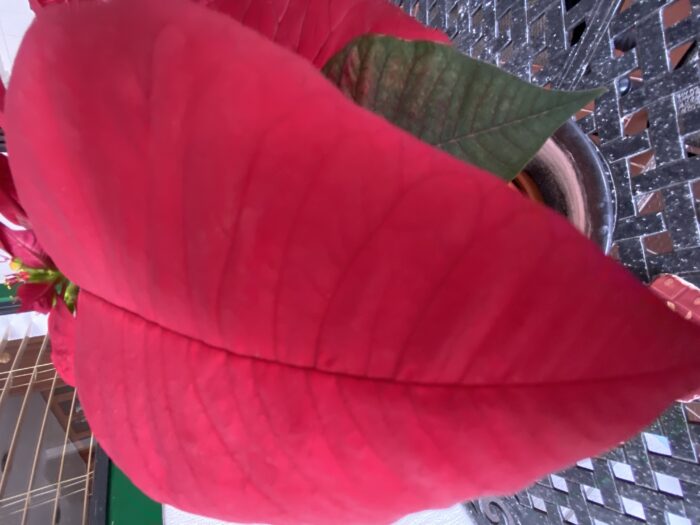
Red Bract 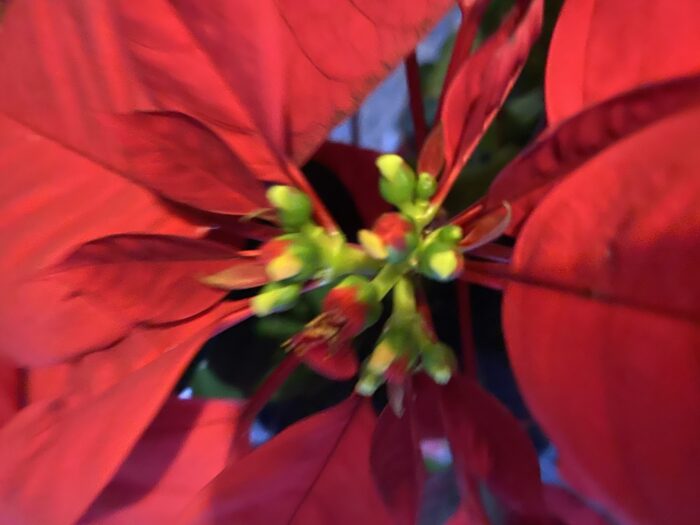
Poinsettia Flower
By the way, technically, Poinsettias aren’t poisonous. However, the milky sap sometimes has negative effects. Pets who consume the sap or eat the leaves can develop vomitng or diarrhea. People with latex allergies can have a skin reaction from touching the leaves.
Initially, Poinsettias were a garden novelty. Towards the end of the 19th century, they were sold as cut flowers. The seasonal potted plants we have today are due to Paul Ecke (1895-1991) who developed the industry. Paul’s father had a dairy farm and orchards near Hollywood, California. In the 1920s, Paul began selling cut Poinsettia flowers on Sunset Boulevard.
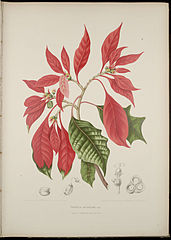
As the movie business grew, farms became displaced. Paul bought land in Encinitas, California, and built a 68 acre ranch. The company moved plant production to greenhouses so they could nurture the plants rather than growing fields of Poinsettias for cut flowers. Paul used grafting technology to develop unique varieties of Poinsettias. He developed plants that look good for the entire holiday season and come in a variety of colors, including pink, white, yellow, purple, salmon, and multi-color. The company also does special orders. For example, a customer may want white Poinsettias to have dyed green highlights , or glitter.
In addition to selling Poinsettias to the market, the Eckes also sell stock plants for other growers to buy and develop for their local markets.
Today the Ecke Ranch is the world’s largest supplier of Poinsettia plants, contributing over $250 million to the U.S. Retail economy.
🌺🌺🌺
Little Mexican Girl, 1905.
Poinsettias, Hawai`i, 1959.
John Roberts Poinsett.
Illustration of Poinsettia Pulcherrima, 1880.
Other Photos by Author.
Poinsettias at Christmas. Why Christmas.
Matt Krantz. “Paul Ecke, Sr.: ‘Poinsettia King’ Cultivated a Holiday Tradition.” Investor’s Business Daily. Nov. 21, 2018.

Sandra Wagner-Wright holds the doctoral degree in history and taught women’s and global history at the University of Hawai`i. Sandra travels for her research, most recently to Salem, Massachusetts, the setting of her new Salem Stories series. She also enjoys traveling for new experiences. Recent trips include Antarctica and a river cruise on the Rhine from Amsterdam to Basel.
Sandra particularly likes writing about strong women who make a difference. She lives in Hilo, Hawai`i with her family and writes a blog relating to history, travel, and the idiosyncrasies of life.

